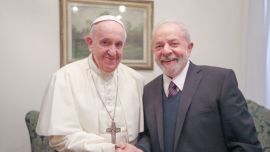“Who is visiting whom?” seems to be the main question. Who is the other? The art of the French collection is visiting Argentina, while Argentines are visiting the show. Peleshyan’s centrepiece, which gave name to the 2014 collaboration between the Argentine artist and the Cartier Foundation, is a black-and-white film showing wildlife fleeing an invisible threat, most likely us human beings. The theatrical Living Room installation contains an audio of Patti Smith on antelopes observing urban life.
Kuitca seems to be suggesting we should look at ourselves. “It’s all very intuitive,” the artist explained in a recent talk. “I am not a curator, and I think more like an artist on how to make all the connections. I saw a lot of the collection, and sometimes there was just a click, that a certain artwork could work well with another.” The artist-turned-curator for the occasion has made a selection based on colour – there is a lot of black-andwhite photography clashing with Lynch’s bright red living room – and time. Films and slide shows – on large screens – follow photos in a dose that the proposal of the show can be taken in.
Some local visitors may feel estrangement, if they are not used to seeing art by either African or Japanese artists. The photos of geometrical African hairdos by J.D. Okhai Ojeikere are beautiful, and the portraits by Seydou Keïta show the proud posing of Malian men in their often European outfits, while the women remain African, with an evenly majestic glance in their eyes. They know they are looked at by the photographer, and now we, in Argentina, are looking at them – intertwining gazes. Daido Moriyama presents a slideshow of his daily city surroundings, from Hong Kong, Los Angeles, Taipei and Tokyo, on four screens, offering an insight into what is common on those faraway streets. Nobuyoshi Araki is also represented by a slideshow and his famous series of erotic bondage nudes.
The more intimate works in the show work best, such as Rinko Kawauchi’s slideshow based on her family. Family is a concept that we can relate to, as well as the universal theme of loss, as presented by Agnès Varda in the video installation The Widows of Noirmoutier. Love, friendship and sadness are all present in Nan Goldin’s fantastic slideshow The Ballad of Sexual Dependency, which in itself is reason enough to make the trip to the CCK: this sequence of photos of her friends between 1979 and 1995 in New York shows an atmosphere of sexual freedom, in the times where AIDS was on the rise. Goldin places herself among her friends and her pictures are so intimate, that we, as visitors, become part of the scene she portrays, sharing in the permeating joy and pain.
Another highlight is the collaborative presentation of William Eggleston’s Kyoto photo series, to which artist-curator Kuitca responds with watercolour-like works that are in fact Eggleston’s photos processed differently. Hung in a corridor, this series is an invitation to look carefully and recognise similarities and differences.
The question of looking becomes most clear upon entering the room with Tony Oursler’s Dead Eyes Live, where huge fiberglass spheres have oversized representations of eyes projected upon them – with imaginary creatures fleeting in front on them.
Is imagination what we need to see? Can truly looking make us see beyond ourselves and free us from being the visitors? Not all the works selected in Les Visitants can trigger this: some are perhaps too far from what we are able to relate to. But some artworks may be able to achieve just that.
WHEN AND WHERE
Les Visitants. Until May, 2018, at the CCK (Sarmiento 151). Opening hours: Wednesday to Sunday, 1pm to 8pm. Free admission. More info: www.cck.gob.ar























Comments